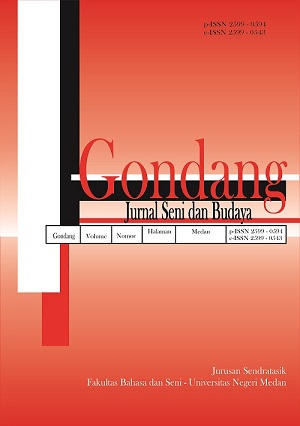Perubahan Fungsi Seni Lebon pada Masyarakat Desa Pepedan Kecamatan Parigi Kabupaten Pangandaran
DOI:
https://doi.org/10.24114/gondang.v3i2.14222Keywords:
Lebon Art, Change in Function of ArtAbstract
This study aims to obtain data on changes in function and initial forms of performing Lebon in the community, Pepedan Village, Parigi District, Pangandaran Regency. This study uses a qualitative descriptive approach. With the development of the current era through various factors, the Lebon art has turned into a means of entertainment that is arranged in such a way that the aim of the Lebon art remains sustainable and is accepted by the Papedan community. Lebon art in the language of the local community lebon has a meaning that is grave or buried. Lebon art performance can occur because there are two groups fighting over plantation land ownership or fighting over women to be wives, Lebon art is art that contains violence in earlier times, because in this art required as winners are surviving champions and losers must reach die and be buried in the place of the Lebon art performance. Lebon art in general Pangandaran community has become an art that was born originally from Pangandaran Regency.References
Bastomi, S, (1992). Wawasan Seni. Semarang: IKIP Semarang Press.
Harsojo. (1967). Pengantar Antropologi. Bandung: Bineka Cipta
Hidayat, R. (2005). Wawasan Seni Tari. Malang : Jurusan Seni dan Desain. Fakultas Sastra Universitas Malang.
Hidayat, R.. (2006). Menerobos Pembelajaran Tari Pendidikan 2. Malang: Banjar Seni Gantar Gumelar.
Iriaji. (2011). Konsep dan Strategi Pembelajaran Seni Budaya. Malang : Pustaka Kaiswaran.
Jazuli, M. (1994). Telaah Teoritis Tari. Semarang: IKIP Semarang Press.
Jazuli, M. (2008). Pendidikan Seni Budaya Suplemen Pembelajaran Seni Tari. Semarang: Universitas Negeri Semarang Press.
Kusaeri. 2014. Acuan dan Teknik Penilaian Proses dan Hasil Belajar dalam
Moleong, L.J. (2007) metodologi penelitian kualitatif. Bandung: PT. Remaja Rosda KArya
Murgiyanto, S. (1996). Cakrawala Kajian Pertunjukan Jurnal Masyarakat Seni Pertunjukan Indonesia Tahun VII. Yogyakarta: MSPI “ Yayasan Bentang Budaya, 1996.
Mustika, I.W. (2012). Teknik Dasar Gerak Tari Lampung. Bandar Lampung: Aura.
Soedarsono. (1978). Pengantar Pengetahuan dan Komposisi Tari. Yogyakarta: Akademi Seni Tari Indonesia.
Sumardjo, J. (2001). filsafat seni. Bandung: ITB.
Sumaryono. (1999). Pengetahuan Iringan Tari Tradisi. Yogyakarta: Jurusan Seni Tari.
Downloads
Published
How to Cite
Issue
Section
License
Copyright (c) 2019 Gondang: Jurnal Seni dan Budaya

This work is licensed under a Creative Commons Attribution 4.0 International License.

This work is licensed under a Creative Commons Attribution-NonCommercial-ShareAlike 4.0 International License.

